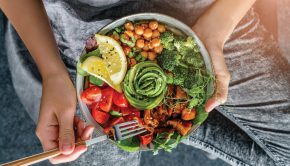GLUTEN-FREE ON THE GO, Safe Eating Away from Home
Although following a diet without gluten has become easier due to increased availability and labeling of gluten-free foods, we still need to know how to make sure which foods strictly qualify. We always have more control in our own kitchen, yet we’re not always eating at home. Natural Awakenings asked experts to comment on reasons for the demand and offer practical tips and tactics for healthy eating on the go.
According to the Center for Celiac Research & Treatment, 18 million Americans are now gluten sensitive, 3 million more suffer from celiac disease, and the numbers continue to skyrocket, says Dr. David Perlmutter, a neurologist and author of Grain Brain. Gluten, a naturally occurring protein in wheat, barley and rye, is prevalent in the modern American diet. Perlmutter points to new wheat hybrids and increasing amounts of gluten in processed foods as exacerbating the problem. He particularly cites today’s overuse of antibiotics and anti-inflammatory medications as contributors to “inappropriate and excessive reactions to what might otherwise have represented a non-threatening protein like gluten.”
Solutions at Work
Jules Shepard, a mother of two in Washington, D.C., and author of Free for All Cooking: 150 Easy Gluten-Free, Allergy-Friendly Recipes the Whole Family Can Enjoy who also shares recipes at Blog.JulesGlutenFree.com, remembers when going out for a gluten-free lunch was difficult. “The friendly lunch spots my coworkers and I used to enjoy on a weekly and sometimes even daily basis were no longer friendly for me,” she says. “There was nothing on the menu I could eat, and it seemed better for everyone if I simply stayed in the office. But it isolated me socially from my colleagues and deprived me of a much-needed midday break that had been such an enjoyable part of my routine.” Attending catered breakfasts or lunches for office meetings also presented difficulties.
Shepard learned that it’s best to be prepared and pack something, even if it’s only a snack. “Some of my favorites include fresh fruit, like apples or bananas with peanut or almond butter, washed berries, applesauce, coconut yogurt, hummus and red peppers, trail mix, dry cereals like granola, and nutrition bars. I keep a variety of these bars in my purse and car year-round, so I’m never bored with my choices.”
“Gluten-free instant oatmeal is a staple in my life,” advises Shepard. She never leaves home without it, regardless of the length of the trip. “All you need is a cup or a bowl and some boiling water. Be sure to buy certified gluten-free oats, because regular oats can be contaminated with gluten grains.” Shepard also recommends avoiding pre-sweetened varieties.
Kate Chan, a teacher and mother of two in suburban Seattle, Washington, who has been following a gluten-free diet since 2000, has solved the problem of eating healthy at work another way: The family cooks extra the night before. “While cleaning up the kitchen, I just pack the leftovers for lunch. I like to vary the side dishes a bit if I pack side dishes at all, and toss in fruit and more vegetables,” she says. Chan likes to use a bento-style lunch box with several compartments, plus thermal containers, so she can enjoy a variety of gluten-free lunch options.
On the Road
In Los Angeles, California, Kristine Kidd, former food editor at Bon Appétit, has recently returned to gluten-free eating. On her menu-planning and recipe blog, KristineKidd.com, and in her cookbook, Weeknight Gluten Free, she recommends whole, fresh foods from farmers’ markets that are naturally gluten-free. When she and her husband hike the Sierra Mountains, she carries homemade, high-fiber, gluten-free cookies to eat on the way up and packs gluten-free soups such as butternut squash and black bean, corn tortillas with fresh fillings, and fruit for a delicious lunch upon reaching the peak.
Some gluten-free snacks can contain as many empty calories as other types of junk food, notes Registered Dietitian Katharine Tallmadge. “Many ‘gluten-free’ products are made with refined, unenriched grains and starches, which contain plenty of calories, but few vitamins or minerals.” She agrees with Kidd and others that choosing whole, natural, fresh foods, which are naturally gluten-free, makes for healthy eating wherever we go.
You Can Take It with You
Our experts suggest delicious, nutritious choices for gluten-free eating at work, play or anywhere we wander. For food safety, keep foods that need to be kept hot and cold in separate thermal containers.
- Asian stir-fry with rice

- Baked egg frittata or baked egg “muffins”
- Baked falafel
- Baked polenta “fries”
- Baked sweet potato chips
- Certified gluten-free instant oatmeal, unsweetened
- Cheese on rice crackers with olive tapenade (purée)
- Corn tortillas with fresh fillings
- Fresh fruits
- Fresh salads, dressing on the side
- Gluten-free granola or granola bars
- Nori (seaweed) wraps
- Precooked quinoa with dried fruit and rice milk
- Raw vegetables with hummus
- Sandwiches made with whole-grain, gluten-free bread
- Smoked fish
- Stew, gumbo or vegetable sautés packed with cooked rice on top
- Vegetable soups with beans or rice
- Vietnamese pho (soup) with rice stick noodles
Judith Fertig blogs at AlfrescoFoodAndLifestyle.blogspot.com from Overland Park, KS.
<












